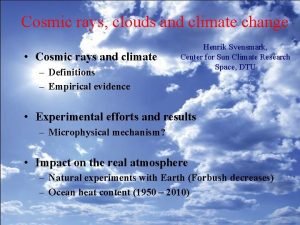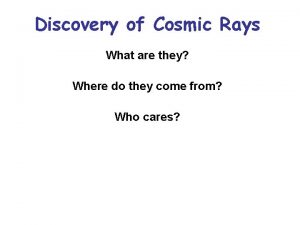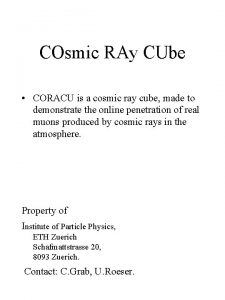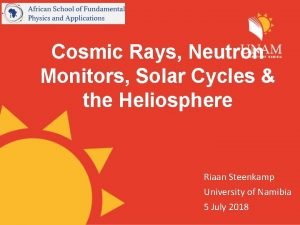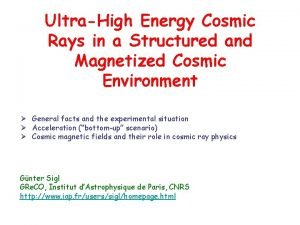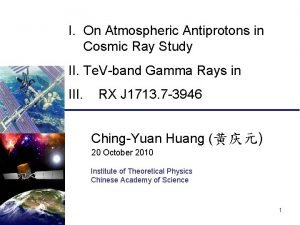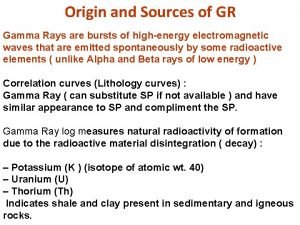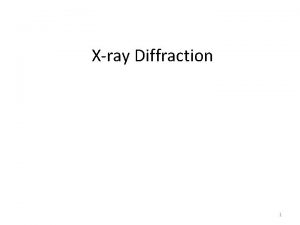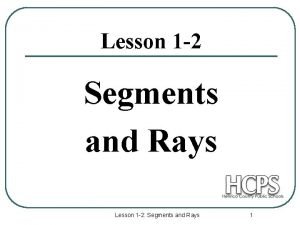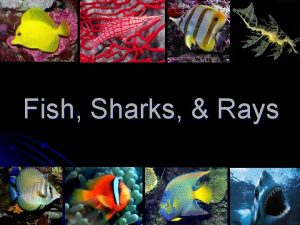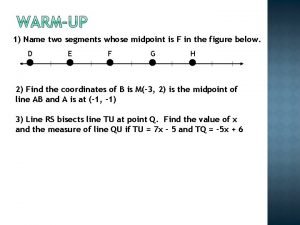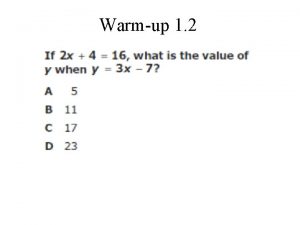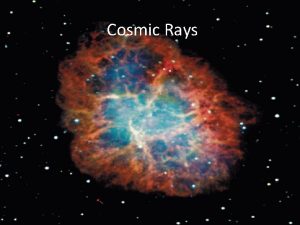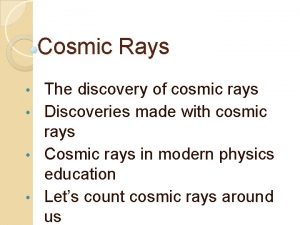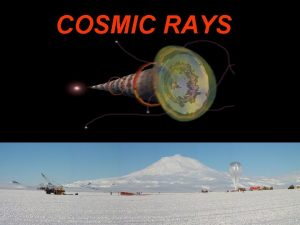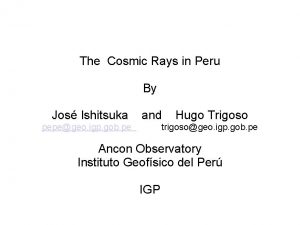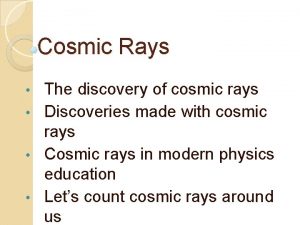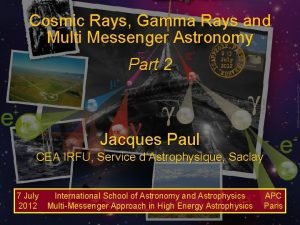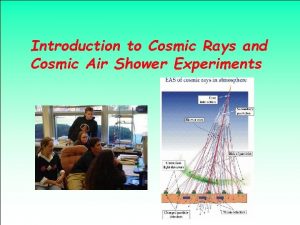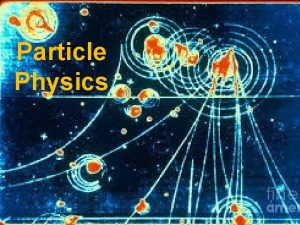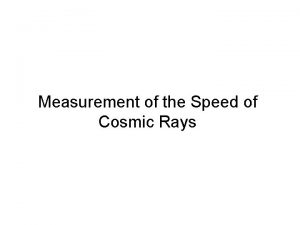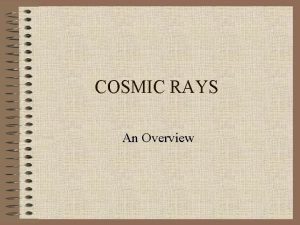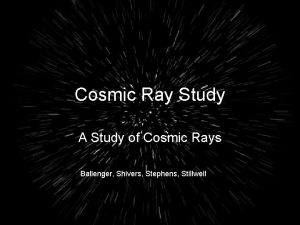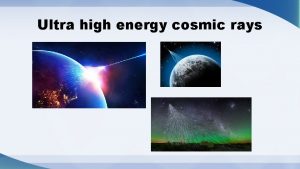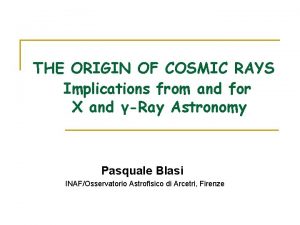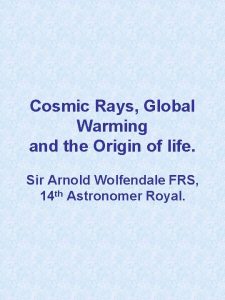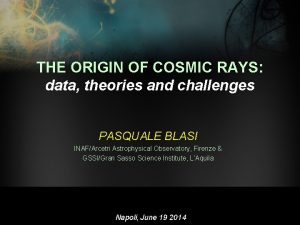The Origin and Acceleration of Cosmic Rays in








































- Slides: 40

The Origin and Acceleration of Cosmic Rays in Clusters of Galaxies HWANG, Chorng-Yuan 黃崇源 Graduate Institute of Astronomy NCU Taiwan

Outline q Clusters of Galaxies q Cosmic-Ray Electrons in Clusters q Conventional Sources of CRs q Cosmic rays from dark matter q Models and Results q Summary

Clusters of Galaxies q Largest gravitational bound systems in the Universe q Thousands of galaxies q Collapse of primordial density peaks q Mass ~ 1015 solar mass q Baryon mass ~ 10% (galaxies and ICM) q mostly dark matter of unknown nature q All might contribute to CRs

Clusters in Optical

Hot Intra-cluster Medium Temperature ~ 108 K ne ~ 10 -3 cm-3 Mass ~ 1014 solar mass Thermal X-ray emission ~ 1044 erg s-1 Energy ~ 1062 erg Cooling time ~ 1018 s Coma (Chandra)

Evidences of Non-thermal Energy in Galaxy Clusters 4 Radio halos and relics – Cosmic rays and magnetic fields 4 Radio Bubbles in X-ray Images – Interaction of cosmic rays and magnetic field with hot ICM – Non-thermal energy is important 4 Magnetic fields: 5 -10 G from Faraday rotation measurements (e. g. Clarke 2001)

Radio Halo and Relic of Coma (Feretti 2003)

Mini Radio Halo in Perseus (Gitti 2003)

Other Evidences of Cosmic Rays in Galaxy Clusters 4 Hard X-ray Excess Emission (? ) – IC scattered of CMB by ~ 104 electrons – Bremsstrahlung of supra-thermal electrons (? X) – Point sources (? ) 4 EUV and Soft X-ray Excess Emission (? ) – IC scattered of CMB by ~ 300 electrons – Only Coma and Virgo Clusters – Other SXE sources are correlated with SXB and must be wrong (Bregman & Lloyd-Davies 2006) 4 Evidences of CRs from HXR/EUV Excess in clusters are not indisputable.

Hard X-ray Excess of Coma (Fusco-Femiano 2003)

SZ effect caused by superathermal model for hard X-ray excess

EUV Excess of Virgo (Berghöfer 2003)

Conventional Sources of CRs 4 Shocks during the formation and evolution of Clusters – Accretion – Mergers 4 Stars: – Normal and starburst galaxies 4 Massive black holes: – Radio galaxies, – Jets of AGNs

Origins of CR Electrons 4 Observationally, we only see CR electrons 4 Since the CR electrons are short-lived, they must be newly (re-)generated. 4 Primary Electrons – Injected from conventional sources: – (Re-)accelerated by shocks 4 Secondary Electrons – Pion decays – Knockon electrons

Problems of CR Electrons 4 Scale size of radio halos >> Vdiffusion tlife – Large-scale sources or re-acceleration 4 The magnetic fields – derived from ICS for EUV/hard X-ray excess ~ 0. 4 G – observed with Faraday rotation ~ a few G 4 Life time of radio halos/relics? 4 Primary or Secondary?

Re-acceleration Models 4 CR electrons are injected by the merger shocks and re-accelerated by ensuing violent turbulence. 4 HXR are ICS of the CMB photons. 4 Try to fit the spectral index distribution. 4 High magnetic fields 4 HXR emission is mainly from low filed regions

Reacceleration Model for Coma (Kuo, Hwang, Ip 2003)

Properties EUV emission 4 CR electrons of the IC EUV: ~ 300 4 IEUV IX-ray 4 EUV emission from Coma might be due to secondary electrons (Bowyer et al 2004)

A Secondary Model 4 Charged pion decays and knockon electrons 4 Cooling mechanisms: synchrotron, ICS of CMB, ionization & bremsstrahlung. 4 Steady state 4 Magnetic Fields ~ 5 G 4 Observed beta model for thermal protons 4 CR proton density?

Assumption of CR protons 4 n. CRp-p 4 p=2. 5 and min( CRp ) ~ 2 4 Total energy density of CR protons: – ~ thermal energy density – ~ 1% of thermal energy density ( ~5 G ) – ~ 0. 01% of thermal energy density (~0. 4 G )

B=5 G, CR Energy density = 1, 0. 0001 thermal energy density, EUV

The Cooling Time for EUV electrons are long! (B=5 G )

One big injection followed by continuum small injections of cosmic-ray electrons can fit the observed EUV and radio data (Tsay, Hwang, Bowyer 2002).

Results for cosmic-ray electrons from conventional sources 4 Successful re-acceleration models of primary electrons for radio/HXE/EUV. 4 EUV-CR electrons might be relic CR electrons and are independent from radio-CR electrons. 4 Secondary models for the EUV emission will overproduce the radio emission. 4 For B=5 G the energy density of CR protons must be less than 1% of thermal energy density in order not to avoid overproducing the radio emission.

DM origins for Cosmic Rays 4 What is dark matter? 4 A viable candidate for the DM is the Weakly Interacting Massive Particles (WIMPs). 4 The most favorable WIMP for DM is the neutralino predicated in the supersymmetric extension of the standard model.

Neutralino 4 A linear combination of two neutral higgsinos and two gauginos. – = B + W + H 1 + H 2 4 The most likely mass of is between ~ 50 Ge. V to 1 Te. V 4 Annihilation of will decay into fermion pairs or gauge boson pairs and will finally become electrons or positrons. 4 Is the resulting relativistic electrons observable?

as the Dark Matter 4 If is the relic particle from the hot big bang and constitute the DM, then 4 mh 2 = 3 10 -27 cm 2 s-1/< v> 4 From WMAP, mh 2 =0. 127, we can fix < v> = 2. 36 10 -26 cm 2 s-1 4 We can estimate the resulting electrons and compare with observations of radio halos in galaxy clusters.

Models for Radio Halo Emission from Dark Matter 4 Select several massive clusters with measured B field (5 -10 G) 4 assume B=5 G and steady state 4 NFW profile 4 < v> = 2. 36 10 -26 cm 2 s-1 4 m =50 Ge. V - 1 Te. V 4 n = cluster mass/volume/m 4 Production rate n 2 < v>

Cluster Sample 4 Coma (NCF, halo) 4 A 754 (NCF, halo) 4 A 85 (CF, relic) 4 A 119 (no radio emission)

Source functions for 1 Te. V , solid line for fermion channels and dashed line for boson channels (Coma)

Equilibrium electron spectra in cluster halos from the annihilation of 1 Te. V (Coma)

Radio power in cluster halos from the annihilation of 100 Ge. V (Coma)

Radio power in cluster halos from the annihilation of 1 Te. V (Coma)

Radio halo flux of Coma compared with radio flux from the annihilation of 100 Ge. V

Radio halo flux of Abell 754 compared with the radio flux from the annihilation of 100 Ge. V

Radio relic flux of Abell 85 compared with the radio flux from the annihilation of 100 Ge. V

Radio flux of Coma compared with theoretical flux of Abell 119 from the annihilation of 100 Ge. V

Radio flux of Coma compared with theoretical flux of Abell 119 from the annihilation of 1 Te. V

Results for DM CRs 4 The predicted radio halo emission from the neutralinos annihilation should be detectable. 4 The non-detection of radio halos for some massive clusters with high magnetic fields can be used to constrain the composition and mass of the DM neutralinos.

Thank you!
 Cosmic rays and clouds
Cosmic rays and clouds Cosmic rays discoverer
Cosmic rays discoverer Cosmic rays
Cosmic rays Cosmic rays
Cosmic rays Cosmic rays
Cosmic rays Cosmic rays
Cosmic rays Origin of gamma rays
Origin of gamma rays Origin of x rays
Origin of x rays Relation between angular and linear quantities
Relation between angular and linear quantities Kinetic angular energy
Kinetic angular energy Centripetal acceleration tangential acceleration
Centripetal acceleration tangential acceleration Is radial acceleration the same as centripetal acceleration
Is radial acceleration the same as centripetal acceleration Radial acceleration definition
Radial acceleration definition Geometry ray definition
Geometry ray definition Lesson 2 segments and rays
Lesson 2 segments and rays Kingdom animalia fish
Kingdom animalia fish Opposite rays example
Opposite rays example Direct and indirect rays of the sun
Direct and indirect rays of the sun Lesson 1-3 segments rays parallel lines and planes
Lesson 1-3 segments rays parallel lines and planes Hát kết hợp bộ gõ cơ thể
Hát kết hợp bộ gõ cơ thể Frameset trong html5
Frameset trong html5 Bổ thể
Bổ thể Tỉ lệ cơ thể trẻ em
Tỉ lệ cơ thể trẻ em Voi kéo gỗ như thế nào
Voi kéo gỗ như thế nào Tư thế worm breton là gì
Tư thế worm breton là gì Chúa yêu trần thế
Chúa yêu trần thế Môn thể thao bắt đầu bằng chữ f
Môn thể thao bắt đầu bằng chữ f Thế nào là hệ số cao nhất
Thế nào là hệ số cao nhất Các châu lục và đại dương trên thế giới
Các châu lục và đại dương trên thế giới Công của trọng lực
Công của trọng lực Trời xanh đây là của chúng ta thể thơ
Trời xanh đây là của chúng ta thể thơ Mật thư tọa độ 5x5
Mật thư tọa độ 5x5 Phép trừ bù
Phép trừ bù Phản ứng thế ankan
Phản ứng thế ankan Các châu lục và đại dương trên thế giới
Các châu lục và đại dương trên thế giới Thơ thất ngôn tứ tuyệt đường luật
Thơ thất ngôn tứ tuyệt đường luật Quá trình desamine hóa có thể tạo ra
Quá trình desamine hóa có thể tạo ra Một số thể thơ truyền thống
Một số thể thơ truyền thống Cái miệng bé xinh thế chỉ nói điều hay thôi
Cái miệng bé xinh thế chỉ nói điều hay thôi Vẽ hình chiếu vuông góc của vật thể sau
Vẽ hình chiếu vuông góc của vật thể sau Biện pháp chống mỏi cơ
Biện pháp chống mỏi cơ
